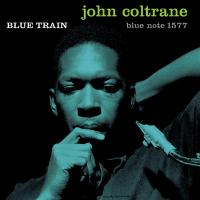I got both; I love the stereo version; the vinyl is dead quiet, and the mono is also excellent. If I had to choose, I would get the mono simply because this is how it was intended to be heard. Either way, you can't go wrong with either or both, which is the way to go.
Outstanding Blue Note Tone Poet Series Reissues of John Coltrane’s Eternal Jazz Classic Blue Train in Separate 180g 1LP Mono and 180g 2LP Stereo Editions Beg the Question: Do You Get One or Both Versions?
Now, I’m not going to spend a lot of time discussing the background of this historic jazz album, as that info has been covered quite extensively here, there, and everywhere over the years. For one thing, Blue Train came in at No. 6 on the AnalogPlanet list of 100 All-Analog Reissues Worth Owning (which you can view here, either as a refresher or as new info).
But the reality is, even those 2014 editions from Music Matters are now fetching some pretty high coin on the collector’s market, and most copies from the 1950s on into the early 1960s on Discogs are selling for well over $150 each — some of them even run into the thousands! — as of this writing.
With the rash of dubious gray market versions of Blue Train flooding the market — i.e., recordings out of copyright overseas imported to the U.S., often featuring incorrect and/or different cover art, and mastered from questionable sources — there was clearly a need for high-quality yet more affordable reissues for the rest of us, and now we have them.
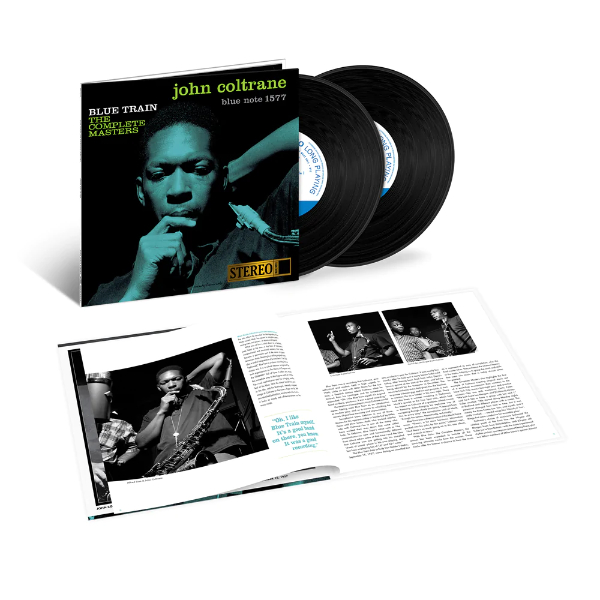
Housed in gorgeous packaging that is now expanded to a gatefold design with lovely photos of the band, the 180g vinyl for the new Blue Train is deep dark black, generally quiet, and perfectly centered. Each LP features period-accurate reproduction of the original Blue Note Records labels — including the “W. 63rd Street” address and band personnel listing, as on the originals — and the discs come to you housed in audiophile-grade protective plastic inner sleeves.
The stereo edition — newly titled Blue Train: The Complete Masters — comes with a bonus LP of excellent alternate takes and outtakes, as well as a lovely LP-sized booklet with expanded liner notes by Grammy Award-winning music writer Ashley Khan. They even reproduced the stereo sticker that was manually applied to the covers of early pressings before Blue Note eventually altered the artwork to designate that it was a stereo recording.
All these details are great. The booklet even goes so far as to explain with great transparency how they created the new master for the bonus disc — including an incredible physical editing process employed for one particular track to restore a solo that had been inserted into the final master take.
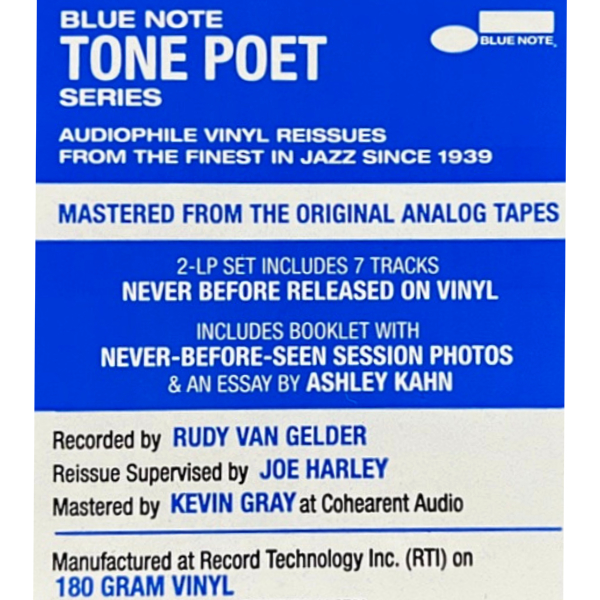
The original September 1957 Blue Train recordings were engineered by the late, great Rudy Van Gelder. These Joe Harley-supervised reissues were newly mastered from the original analog tapes by Kevin Gray at Cohearant Audio. The 180g vinyl was manufactured at RTI.
Again, this is all good stuff, folks. Depending on where you shop, some of you might get a little surprise when you realize that to procure both the mono and stereo editions of Blue Train, it will run you upwards of $100. Here in San Francisco, for example, the mono goes for about $40, and the stereo goes for nearly $60. For three LPs, this really is a fair deal, all things considered — especially given the extremely high production values of these packages. Still, a hundred bucks is a hundred bucks, and some of you may not be prepared to spend that much for, essentially, one album — no matter how classic it is.
I know some of you are wondering which version to buy, if you had to choose between the two. I’ve read discussions on this very topic on social media, in fact, but the good news is, both the mono and stereo editions of Blue Train are indeed excellent, each of them offering a different and distinct listening experience.
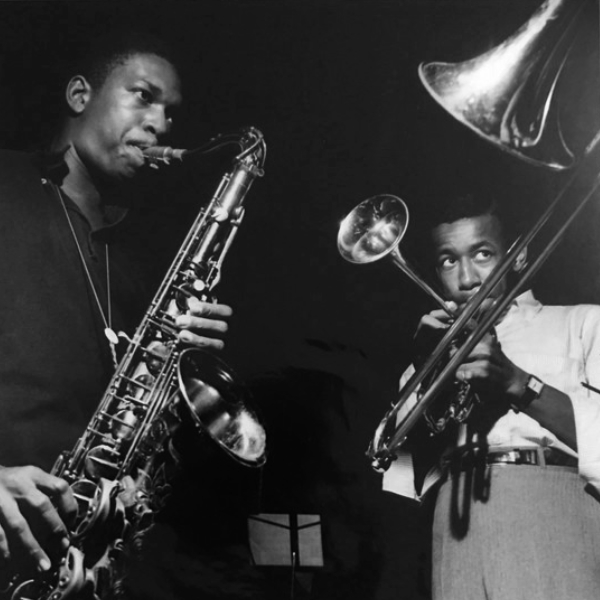
And thus, it is here where the choice might get challenging. It is generally accepted knowledge that after a point in 1958, acclaimed recording engineer Rudy Van Gelder — who, again, engineered these Blue Train sessions — pretty much recorded everything in stereo, and then folded down those tracks to make a mono master. Mono was still the dominant format for quite a number of years into the early 1960s, but Blue Train was recorded in late 1957, just before that transition point. It was around the time that Van Gelder began experimenting with recording in stereo. That said, AnalogPlanet reached out to Blue Note Tone Poet reissue supervisor/producer Joe Harley directly, who indeed confirmed for us (in italics):
Rudy was still recording dedicated mono and stereo at this time by running parallel stereo and full-track mono decks during the Blue Train session, thus no mono fold downs.
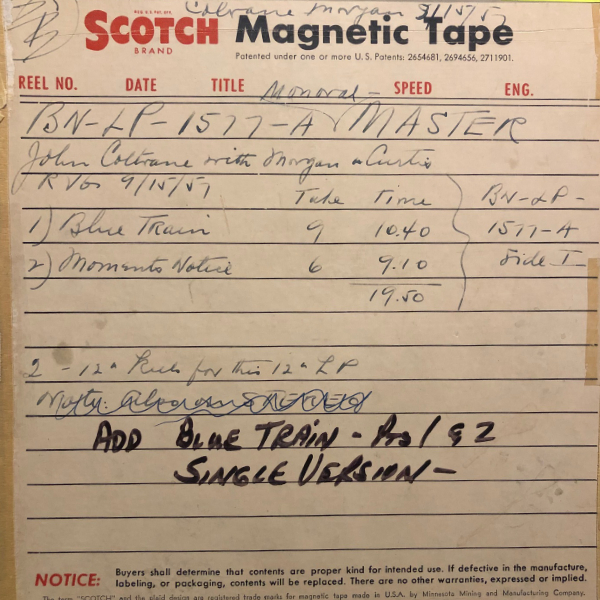
From the RVG Legacy site, we can glean a bit more insight (also in italics): Van Gelder used his newly acquired Ampex 350-2P portable two-track tape recorder for the occasion (Wolff, 1957). A few months later in May, Blue Note started recording all their sessions to both full-track (mono) and two-track (stereo) tape. However, skeptical of stereo’s staying power in the marketplace, the label wouldn’t actually release their first stereo albums to the public for two more years.
The Music Matters site concurs, with additional notes (again, in italics): Rudy Van Gelder first began recording Blue Note sessions in stereo in March of 1957. From then until an October 30, 1958 Art Blakey session, Rudy simultaneously ran both mono and stereo session tapes. After that session, Rudy abandoned the practice of running both mono and stereo session tapes and recorded strictly in stereo.
Finally, according to the Blue Train liner notes, the session was recorded on September 15, 1957 at Van Gelder Studios in Hackensack, New Jersey.
Having thus confirmed there are indeed two distinct versions of Blue Train available — each offering a different listening experience — the inevitable consumer question arises again: Which one do I get?
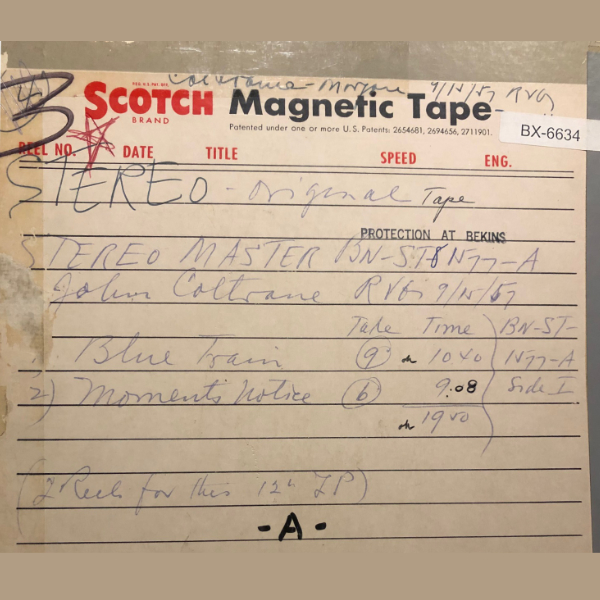
If $100 isn’t an issue for you — and if you absolutely love John Coltrane’s music, and this album in particular — then the smart and optimum choice would be to buy both versions. You will enjoy decidedly distinct listening experiences from each version. [MM interjects: Like I just did myself!]
If you must make a choice and aren’t hung up on things like soundstage and such, then the stereo version offers the best value proposition. There you will get two (count ’em!) fine-sounding 180g LPs, plus the fabulous bonus booklet that is not in the mono edition. Generally, the stereo edition sounds great. There is plenty of air in this stereo recording, and the bass is plenty prominent. All the instruments sound rich and realistic, and the drums are especially crisp and detailed. Plus, you get an entire disc of outtakes and alternate versions — which, if you know Trane, can often be as invigorating as the saxophonist’s master takes.
True personal sidenote: The first Coltrane album I ever bought with my own money was when I was still in junior high school — and it was his 1974 posthumous release, Alternate Takes. And, in many ways, I prefer those versions to the master takes, many of which came from the 1959 Giant Steps sessions.
Here, however, is where my personal preference gets in my own way on this issue — and I readily acknowledge this view may well differ from many of yours. As nice as Blue Train: The Complete Masters sounds in stereo, the mono mix rings a bit truer for me. In contrast, the mono mix seems to have been mastered a little more quietly than the stereo, but when you turn up the volume, you feel that classic late-’50s RVG jazz sound. The rhythm section is locked-in together dead-center, providing a buoyant, swinging base for Trane’s improvisations to float over.
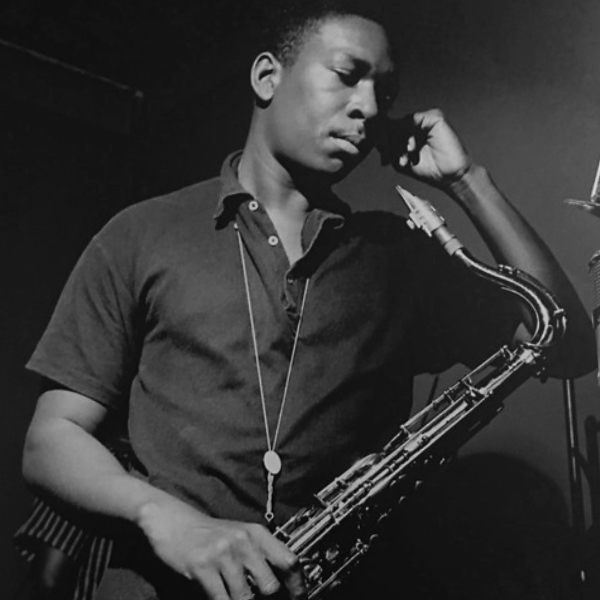
Oddly enough, I find the instrumentation a bit more distinct, balanced, and even punchy on the mono mix. It seems to swing a bit more for my tastes. What I am sensing is kind of akin to the difference between the original mono version of The Beatles’ June 1967 Sgt. Pepper’s Lonely Hearts Club Band album vs. the stereo. To me, the mono edition feels more impactful, direct, and immediate. [MM adds: We do know The Beatles intended Sgt. Pepper to be mono, with the stereo mix done practically at the last minute — but that’s a thread discussion for another post, and/or the Comments section.]
Even though the stereo edition of Blue Train technically probably delivers more dynamic range and the feel of the studio the band was recording in — that sense of airiness and all those nuanced sonic details we audiophiles cherish — this mono edition is probably closer to what most people first heard when Blue Train was released. Remember, radio was in mono. Most hi-fi systems at the time were still mono. Stereo was then a newfangled concept being rolled out to early adopters, with an eye to hopeful mainstream success in a fast-approaching future. And Blue Train was no doubt an early attempt at mixing for stereo in real time, even for an engineer of Van Gelder’s stature.
Growing up as a child of the ’60s, I can confirm we didn’t get a stereo in our household until around 1967, when my oldest teenage brother got an all-in-one system featuring a Garrard automatic changer built into it — with a ceramic cartridge! — and detachable little speakers. Prior to that, everything was all-mono.
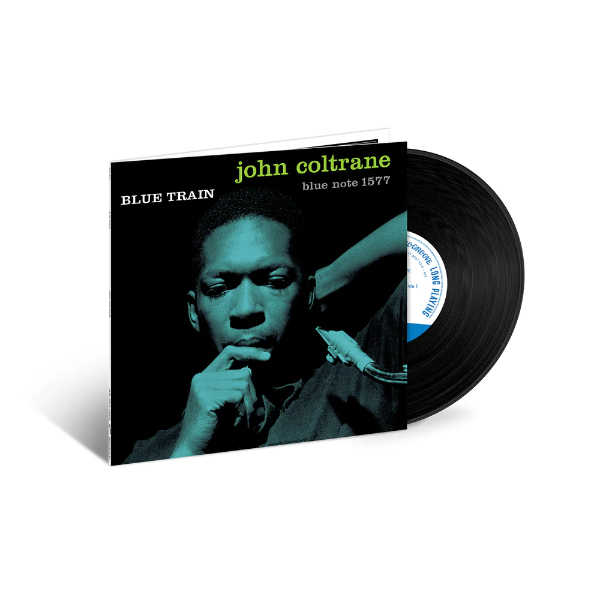
Again, the point here is to simply underscore each version of the Blue Train album presents a distinct listening experience — both of which are valid and relevant to the history of this music.
Don’t get me wrong — I really do like the stereo edition. In fact, I like that package so much that I asked AP editor Mike Mettler if I could keep the stereo copy he sent me so I could do this review, as I had separately purchased my own copy of the mono edition. [MM confirms: As I alluded to in an earlier parenthetical aside, I went ahead and bought both mono and stereo copies of Blue Train, so I did indeed tell Mark he could keep the stereo version I sent him for this review!]
If you aren’t a Coltrane completist like I am, or simply want a more affordable entry point to this historical album, then grab the 1LP mono edition. Either way — mono or stereo — you won’t go wrong. These two new Blue Note Tone Poet editions of Blue Train offer great-sounding presentations of this truly legendary jazz recording.
(Mark Smotroff is an avid vinyl collector who has also worked in marketing communications for decades. He has reviewed music for AudiophileReview.com, among others, and you can see more of his impressive C.V. at LinkedIn.)
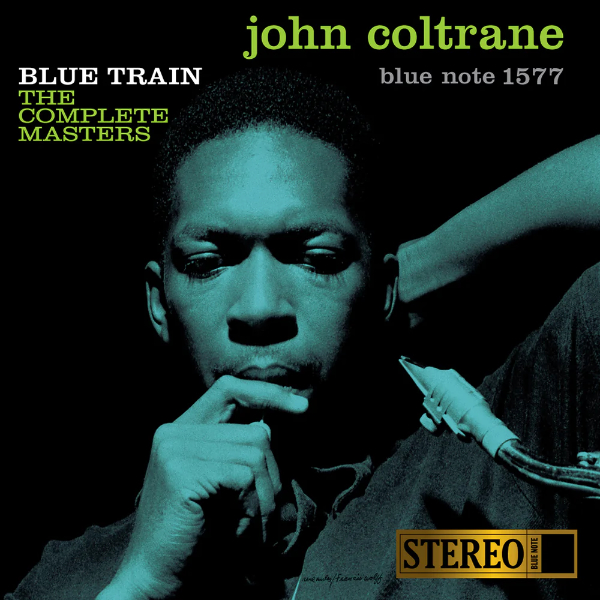
JOHN COLTRANE
BLUE TRAIN: THE COMPLETE MASTERS — STEREO EDITION
180g 2LP (Blue Note Tone Poet Series)
Side A
1. Blue Train
2. Moment’s Notice
Side B
1. Locomotion
2. I’m Old Fashioned
3. Lazy Bird
Side C
1. Blue Train – False Start *
2. Blue Train – Alternate Take 7 *
3. Moment’s Notice – Alternate Take 4 *
4. Lazy Bird – Alternate Take 1
Side D
1. Blue Train – Alternate Take 8
2. Moment’s Notice – Alternate Take 5A (Incomplete) *
3. Lazy Bird – Alternate Take 2
*denotes previously unreleased track
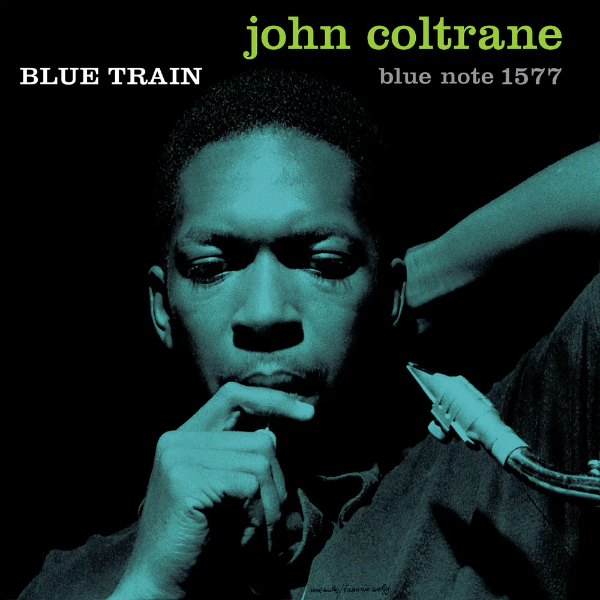
JOHN COLTRANE
BLUE TRAIN — MONO EDITION
180g 1LP (Blue Note Tone Poet Series)
Side A
1. Blue Train
2/ Moment’s Notice
Side B
1. Locomotion
2. I’m Old Fashioned
3. Lazy Bird
- Log in or register to post comments

I read up on the stereo vs mono question before pulling the trigger as well, but in all honesty it's a decision I wrestled with for all of about 5 seconds.
Given that neither version is more "artistically intended" than its counterpart, and given that the rest of the mastering/production chain is virtually the same, this is kind of a golden opportunity to get some insight into RVG's process and approach to experimenting with a newfangled format.
Also, given the fact that Joe Harley's BN reissues have a history of increasing in value, getting both REALLY becomes a no-brainer. (That's what I told my better half, anyway. I'm sure I'll never sell either.)
Love to hear from more folks about how they like the mono version.

if I have a different one, but for me, to decide in terms of what sounds best, your following arguments seem completely irrelevant:
What people at the time it came out, had to live with and how they first heard it (mono equipment etc.). It’s purely nostalgic, wanting to hear as they did (or better had to).
The rhythm section locks in dead center? Well yes, that’s mono and only works there. If you press the mono switch it also works for Billie Eilish.
That every mono record seems to have a tad more bass? Yes, and if this is what the recording needs, it can sound more impactful. A reason for many to prefer mono, but depending a bit on the voicing of one’s setup.
The stereo version is much airier, I agree.
So finally, the argument Kevin Gray used in a recent interview (I think with Steve Westman), why he tends to prefer the mono, was more specific, but probably not everyone hears what he named (I didn’t try so far and don’t remember exactly without watching it again).

the Music Matters version several years ago. That was mono. So, I bought the Stereo version this time, which sounds great.
I'm curious if you know - did Kevin Gray do new acetates for the Tone Poet Mono version or are they the same as the Music Matters (i.e. the same metal parts)? If they are new acetates - did anyone out there get a chance to compare the MM mono to the new Tone Poet Mono?

as well as the Classic Records up to the single sided 45RPM and the old AP45RPM.
And yes the Tone Poet and the Music Matters mono are different cuts, and yes, I recently compared them.
In my grading I marked them on equally high level with the Music Matters (non SRX) EQ’ed a bit more solid in bass and a tiny bit more conservative on top end, the Tone Poet with slightly more pronounced upmost treble details and a little less compact sounding.
It’s really about very fine details only, not worth thinking about, except if your system‘s voicing is on the edge and needs the one or other direction.

They come to a very similar conclusion regarding the monos - just completely reversed as I understood.
So I have to re-check on occasion in case I confused the two.

but they stay as they are, I hear it that way and today I even had a certain preference for the slighty more transparent sound of the Tone Poet release. The Music matters a little more compact sounding with maybe a bit more air/aura in deeper sax sounds, the TP a bit more transparent and open above.
It’s still nuances and a bit confusing (I think I remember even the two reviewers in the video had slightly opposing arguments) but both releases interesting enough to have.

the Music Matters version several years ago. That was mono. So, I bought the Stereo version this time, which sounds great.
I'm curious if you know - did Kevin Gray do new acetates for the Tone Poet Mono version or are they the same as the Music Matters (i.e. the same metal parts)? If they are new acetates - did anyone out there get a chance to compare the MM mono to the new Tone Poet Mono?

Buy the one that interests you the most, enjoy the heck out of it, then give the price of the other to help hurricane Ian victims or to an organization helping Ukrainian refugees.

So I have an original mono pressing. My friends grand father has a warehouse in ENY Brooklyn he use to distribute Blue Note records.The RVG sounds great but the new mono sounds much cleaner. They said they did minor adjustments and it not noticeable to my ears.
Buy it

I was thinking that after the MoFi-case the labelling would improve. But still they put a sticker on the record with "mastered from original analog tapes" that says absolutely nothing about the mastering chain. Why can't they use the "AAA" or in this case - I guess - "ADA" on their sticker. I would buy it anyway, but would appreciate to get this information easely. It would be good for the future, too. If we get a lot of good sounding ADA-pressings we could get rid of our digital fear.

Can I play the mono version with a regular cartridge? Or, do I need a specific cartridge for the mono version?

Yes. The pressings today are all microgroove records cut to the standard of today. Your Stereo cart will track it fine.
Some say a mono cart for a mono record. That applies most with old 50s era presssings.
Play this new mono on your stereo. If you have a stereo/mono switch , use it.
Now dig it.

All mono records can be played with a stereo stylus. Enjoy the music

Contrary to Karl Marx, religion isn't the opiate of the masses. Ignorance is.
Ignorance allows you to arrive at outrageous conclusions, and believe any thing you want to believe.
Rudy Van Gelder was never highly admired or respected during his heyday. Neither Blue Note, Prestige, or any of the other record labels for whom he supplied recordings.
It was only when Miles Davis signed with Columbia that he considered a huge step up from his previous recording sessions. Columbia was the big time. He had made it. Prestige? Blue Note? Nope.
You, and so many listeners are viewing Van Gelder thru a rose-colored, ignorance-adoration prism of today. In his day, Van Gelder was regarded as utilitarian and unimaginative, laboring away for a multitude of second tier labels. He lacked the resources and budgets available to the recording engineers and producers working for the majors.
Privately, professionals were quite a bit crueler towards guys such as Van Gelder. A major recording engineer mocked and chided Van Gelder's recording procedures. He laughed at Van Gelders habit of making a copy of the final master tape - a generation step down from the assembled final master. Totally unnecessary, but that was the copied tape from which the records were to be pressed.
If I remember correctly, Van Gelder always rolled off the bass below some frequency; maybe not on the session tapes, but on the stepped down, second gen master sent to the pressing plant.
And, there were other unnnecessary compromises. Gritty distortion levels were high on Van Gelders one-generation step down tapes.
I don't recall the whole list of them, but when I first heard of them back in the day, they struck me as ridiculous.
Keeping in mind that until he built a professional recording studio in Englewood Cliffs, NJ, Van Gelder was recording in a domestic living room - his parents living room.
To make those living room recordings, musicians were sardined next to each other in any way that they could fit. The only way to record under those circustances was to multi-mike - and that's exactly what Van Gelder did. Aggressively. Air and open space? Pffft.
"An engineer of Van Gelder’s stature?
Yeah. The stature of a joke.
